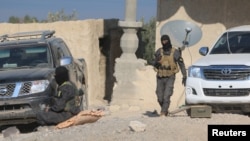Nearly two weeks after regaining control of a strategic dam in northern Syria, Kurdish-led forces are struggling with continued blitzes from Islamic State militants who want to retake the area.
The fighting centers on the 900-meter-long Tishrin Dam, held by IS for more than a year until Kurdish and coalition forces retook it in December. It supplies electricity to much of northern Syria.
On Thursday, a group of IS fighters attempted to infiltrate the nearby Kurdish-held town of Ain Issa. But local forces were able to thwart the plan, according to reports.
Another group of IS fighters entered the town of Sarrin, not far from Tishrin Dam, crossing from the western side of the Euphrates River. Fierce clashes erupted between them and the YPG Kurdish forces.
“Daesh [IS] wants to retake Tishrin Dam for strategic and symbolic reasons at the same time,” said Shervan Derwish, a spokesman for the Syrian Democratic Forces (SDF), a group of Kurdish, Arab and Christian fighters.
IS pressure
With inclement weather in the region, U.S.-led coalition airstrikes on IS positions have slowed. This has allowed IS to reorganize its forces in order to make advances, Kurdish commanders said.
“They take advantage of weather conditions to wage constant attacks on our forces there,” Derwish told VOA.
He said IS had brought additional fighters from Damascus and Homs to participate in the operations against Kurdish forces and their allies.
In the recent battles with Kurdish forces, IS has used tanks and heavy weapons.
The latest advances made by SDF near Tishrin and other areas south of Kobani have placed more pressure on IS militants, who are having difficulty moving from areas in eastern Syria to the parts they control in Aleppo and elsewhere.
“Tishrin Dam is now no longer in their [IS] hands, so they have to go all the way around,” said Brett McGurk, U.S. special presidential envoy for the Global Coalition to Counter IS, during a recent briefing at the State Department.
Coalition forces
U.S.-led coalition forces and their local partners on the ground are working on pushing IS militants back to Raqqa, the de facto capital of their self-styled caliphate in Syria, officials said.
“We’re going to continue to isolate and constrict [IS] in Raqqa,” McGurk said.
Turkish officials, however, continue to express concerns about Kurdish advances in northern Syria. Military leaders in Ankara this week told U.S. General Joseph Dunford that Syrian Kurdish forces were attempting to create a “Kurdish corridor” in Syria’s north, according to Turkish news reports.
Dunford was in Turkey to meet with Turkish officials, including Prime Minister Ahmet Davutoglu, and to visit U.S. troops who are stationed at Incirlik Air Base.
Turkey considers Kurdish forces in Syria as part of the Kurdistan Workers’ Party (PKK), which Ankara and Washington see as a terrorist group.










